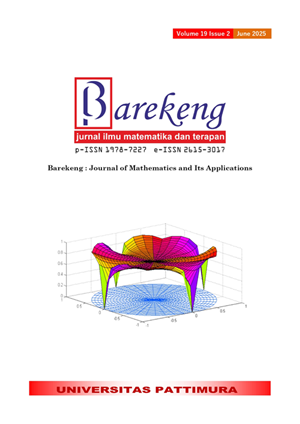APPLICATION AND PERFORMANCE COMPARISON OF MULTI-OUTPUT MACHINE LEARNING FOR NUMERICAL-NUMERICAL AND NUMERICAL-CATEGORICAL OUTPUTS
Abstract
Multi-Output Machine Learning is an advancement of traditional machine learning, designed to predict multiple output variables simultaneously while considering the relationships between these output variables. Multi-Output Machine Learning is essential as a decision support tool because decision-making in many problems generally considers multiple factors. The use of Multi-Output Machine Learning is more advantageous than conventional machine learning in terms of time efficiency, addressing data limitations, and ease of maintenance. These benefits will significantly impact cost savings for industries utilizing Big Data. The models used in this research include Multivariate Regression Tree, Multivariate Random Forest, and Multi-Output Neural Network. The Multivariate Regression Tree and Multivariate Random Forest are developed by modifying the splitting function using Mahalanobis distance. The topological changes introducing shared and private hidden layers are the key development of the Multi-Output Neural Network. The prediction results indicated a trade-off in error between two output variables when comparing the Multivariate Regression Tree and Multivariate Random Forest with their single output counterparts. Meanwhile, the Multi-Output Neural Network model successfully improved the prediction results for both output variables. This research also introduces Mixed Multi-Output Machine Learning, which can predict numerical and categorical output variables. The Mixed Multi-Output Machine Learning model utilizes the logit values from the Logistic Regression model to extend the range of prediction results beyond the 0 to 1 interval. Multi-Output Neural Network is the sole model that produces predictions with relatively small errors and high accuracy values.
Downloads
References
R. Sharma, S. Mithas and A. Kankanhalli, "Transforming decision-making processes: a research agenda for understanding the impact of business analytics on organisations," European Journal of Information Systems, vol. 23, no. 4, pp. 433-441, 2014.
G. Li, W. Tian and H. a. C. B. Zhang, "Building energy models at different time scales based on multi-output machine learning," Buildings, vol. 12, no. 12, p. 2109, 2022.
H. Zare Abyaneh, "Evaluation of multivariate linear regression and artificial neural networks in prediction of water quality parameters," Journal of Environmental Health Science and Engineering, vol. 12, pp. 1-8, 2014.
L. Schmid, A. Gerharz, A. Groll and M. Pauly, "Tree-based ensembles for multi-output regression: Comparing multivariate approaches with separate univariate ones," Computational Statistics & Data Analysis, vol. 179, p. 107628, 2023.
L. Cui, X. Xie, Z. Shen, R. Lu and H. Wang, "Prediction of the healthcare resource utilization using multi-output regression models," IISE Transactions on Healthcare Systems Engineering, vol. 8, no. 4, pp. 291-302, 2018.
L. He, S. C. Madathil, G. Servis and M. T. Khasawneh, "Neural network-based multi-task learning for inpatient flow classification and length of stay prediction," Applied Soft Computing, vol. 108, p. 107483, 2021.
V. G. Costa and C. E. Pedreira, "Recent advances in decision trees: An updated survey," Artificial Intelligence Review, vol. 56, no. 5, pp. 4765-4800, 2023.
G. O. Ndong, J. Villerd, I. Cousin and O. Therond, "Using a multivariate regression tree to analyze trade-offs between ecosystem services: Application to the main cropping area in France," Science of The Total Environment, vol. 764, p. 142815, 2021.
S. J. Rigatti, "Random forest," Journal of Insurance Medicine, vol. 47, no. 1, pp. 31-39, 2017.
S. Gharsalli, B. Emile, H. Laurent, X. Desquesnes and D. Vivet, "Random forest-based feature selection for emotion recognition," in 2015 International Conference on Image Processing Theory, Tools and Applications (IPTA), Orléans, 2015.
M. López, O. Antonio, A. Montesinos López and J. Crossa, Multivariate statistical machine learning methods for genomic prediction, Springer Nature, 2022.
M. Heidarpanah, F. Hooshyaripor and M. Fazeli, "Daily electricity price forecasting using artificial intelligence models in the Iranian electricity market," Energy, vol. 263, p. 126011, 2023.
C. C. Aggarwal, "The Backpropagation Algorithm," in Neural networks and deep learning, Springer, 2018, pp. 29-71.
J. Wu and Y. Sun, "Evolving deep parallel neural networks for multi-task learning," in International Conference on Algorithms and Architectures for Parallel Processing, Xiamen, 2021.
G. James, D. Witten, T. Hastie and R. Tibshirani, An Introduction to Statistical Learning: with Application in R, 2nd ed., New York: Springer Nature, 2021.
Copyright (c) 2025 Karin Joan, Robyn Irawan, Benny Yong

This work is licensed under a Creative Commons Attribution-ShareAlike 4.0 International License.
Authors who publish with this Journal agree to the following terms:
- Author retain copyright and grant the journal right of first publication with the work simultaneously licensed under a creative commons attribution license that allow others to share the work within an acknowledgement of the work’s authorship and initial publication of this journal.
- Authors are able to enter into separate, additional contractual arrangement for the non-exclusive distribution of the journal’s published version of the work (e.g. acknowledgement of its initial publication in this journal).
- Authors are permitted and encouraged to post their work online (e.g. in institutional repositories or on their websites) prior to and during the submission process, as it can lead to productive exchanges, as well as earlier and greater citation of published works.






1.gif)



